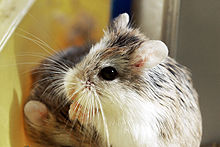- Cricetidae
-
Cricetids
Temporal range: Middle Miocene–Recent
Meadow Vole
Microtus pennsylvanicusScientific classification Kingdom: Animalia Phylum: Chordata Class: Mammalia Infraclass: Eutheria Superorder: Euarchontoglires Order: Rodentia Suborder: Myomorpha Superfamily: Muroidea Family: Cricetidae
J. Fischer, 1817Subfamilies Arvicolinae
Cricetinae
Neotominae
Sigmodontinae
Tylomyinae
and see belowThe Cricetidae are a family of rodents in the large and complex superfamily Muroidea. It includes true hamsters, voles, lemmings, and New World rats and mice. At almost 600 species, it is the second largest family of mammals, and has members throughout the New World, Asia, and Europe.
Contents
Characteristics
The cricetids are small mammals, ranging from just 5–8 cm (2.0–3.1 in) in length and 7 g (0.25 oz) in weight in the New World Pygmy Mouse up to 41–62 cm (16–24 in) and 1,100 g (39 oz) in the Muskrat. The length of the tails varies greatly in relation to the body, and they may be either furred or sparsely haired. The fur of most species is brownish in colour, often with a white underbelly, but many other patterns exist, especially in the cricetine and arvicoline subfamilies.
Like the Old World Mice, cricetids are adapted to a wide range of habitats, from the high Arctic to tropical rainforests and hot deserts. Some are arboreal, with long balancing tails and other adaptations for climbing, while others are semiaquatic, with webbed feet and small external ears. Yet others are burrowing animals, or ground-dwellers.[1]
Their diet is similarly variable, with herbivorous, omnivorous, and insectivorous species all being known. They all have large, gnawing, incisors separated from grinding molar teeth by a gap, or diastema. Although there are a few exceptions, the dental formula for the great majority of cricetids is:
Dentition 1.0.0.3 1.0.0.3 Cricetids' populations can increase rapidly in times of plenty, due to a combination of short gestation period of between 15 and 50 days, and large litter sizes relative to many other mammals. The young are typically born blind, hairless, and helpless.[1]
Evolution and systematics
 Roborovski's Dwarf Hamster (Phodopus roborovskii) of the Cricetinae
Roborovski's Dwarf Hamster (Phodopus roborovskii) of the Cricetinae
The cricetids first evolved in the Old World during the Miocene. They soon adapted to a wide range of habitats, and spread throughout the world. The voles and lemmings arose later, during the Pliocene, and rapidly diversified during the Pleistocene.[2]
The term Cricetidae has gone through several permutations, and members of the family as currently defined are often placed in the family Muridae along with all other muroid subfamilies. Many other muroids have been called members of the Cricetidae in the past such as mouse-like hamsters (subfamily Calomyscinae, family Calomyscidae), gerbils (subfamily Gerbillinae, family Muridae), the crested rat (subfamily Lophiomyinae, family Muridae), zokors (subfamily Myospalacinae, family Spalacidae), the white-tailed rat (subfamily Mystromyinae, family Nesomyidae), and spiny dormice (subfamily Platacanthomyinae, family Platacanthomyidae). Multigene DNA sequence studies have shown that the subfamilies listed below are related (i.e. form a monophyletic group), and that the other muroids should not be included in the Cricetidae.[3]
The cricetids are thus classified to contain one prehistoric and 5 living subfamilies, around 112 living genera and approximately 580 living species:
- Arvicolinae — voles, lemmings, muskrat
- Cricetinae — hamsters
- Democricetodontinae † (fossil)
- Neotominae — North American rats and mice, including deer mice, pack rats, and grasshopper mice
- Sigmodontinae — New World rats and mice, predominantly South American genera such as brucies.
- Tylomyinae — New World climbing rats and relatives
Footnotes
References
- Eisenberg, J.F.; Feaver, J. & Krebs, C.J. (1984): Cricetidae. In: Macdonald, D. (ed.): The Encyclopedia of Mammals: 640–655, 672–673. Facts on File, New York. ISBN 0-87196-871-1
- Jansa, S.A. & Weksler, M. (2004): Phylogeny of muroid rodents: relationships within and among major lineages as determined by IRBP gene sequences. Mol. Phyl. Evol. 31(1): 256–276. doi:10.1016/j.ympev.2003.07.002 PMID 15019624 PDF fulltext
- Michaux, Johan; Reyes, Aurelio & Catzeflis, François (2001): Evolutionary history of the most speciose mammals: molecular phylogeny of muroid rodents. Mol. Biol. Evol. 18(11): 2017–2031. PDF fulltext
- Norris, R.W.; Zhou, K.Y.; Zhou, C.Q.; Yang, G.; Kilpatrick, C.W. & Honeycutt, R.L. (2004): The phylogenetic position of the zokors (Myospalacinae) and comments on the families of muroids (Rodentia). Mol. Phyl. Evol. 31(3): 972–978. doi:10.1016/j.ympev.2003.10.020 PMID 15120394
- Savage, R.J.G. & Long, M.R. (1986): Mammal Evolution: an illustrated guide. Facts on File, New York. ISBN 0-8160-1194-X
- Steppan, S.J.; Adkins, R.A. & Anderson, J. (2004): Phylogeny and divergence date estimates of rapid radiations in muroid rodents based on multiple nuclear genes. Systematic Biology 53(4): 533–553. doi:10.1080/10635150490468701 PMID 15371245 PDF fulltext
Categories:- Muroid rodents
- Cricetidae
Wikimedia Foundation. 2010.
